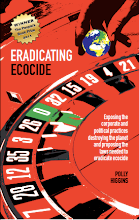Paragraph 13 of the Non-Paper No 52 (of the Ad-hoc Working Group on Long-term Co-operative Action under the Convention, to give it it's full title) currently states:
"Noting that a shared vision for long-term cooperative action should take account not only of the rights of human beings, but also of the rights of Mother Earth and all its natural beings as the adverse effects of climate change also have a range of direct and indirect implications for the full and effective enjoyment of human rights - including the right to sustainable development, self determination, statehood, life, the right of people not to be deprived of their own means of subsistence, the right to water and the right to live well - and are increasingly posing a risk to security and the survival, sovereignty and territorial integrity of states."
As of yet, the inherent rights of the wider earth community have not been included. The rights listed are are specifically human-centered. Most are not rights identified in the Universal Declaration of Human Rights (the exception being right to life), nor are they enshrined in national or international legislation. The proposed list does not take into account of the wider inherent rights that apply equally to all beings (including humans).
The inherent rights and freedoms that could be included here are:
1. the right not to be polluted;
2. the right to restorative justice; and
3. the freedom of a clean and healthy environment.
The implications of such wording for the future protection of biodiversity and restoration of large degraded eco-systems is of course enormous.
The right not to be polluted
By definition, pollution is the introduction of contaminants - be they synthetic or an excess of natural - into the environment that cause instability, disorder, harm or discomfort to physical systems and living organisms. Thus, the excess of greenhouse gases can be termed a pollutant. Such legislation is necessary to stop the continuance of large scale creation of GHG’s that are damaging to people and planet. Until we actually stop the pollution at source, no amount of offsetting, carbon crediting or carbon capture and storage will solve the problem.
On 17.04.09 the US Environmental Protection Agency ruled that excess greenhouse gas emissions are to be now termed as _"pollutants, which are a danger to public health"._ Greenhouse gases are also a danger to all beings health, as is cogently demonstrated by the loss of numerous species (the polar bear being the most obvious example). Likewise, Europe is now considering implementing a similar directive.

The right to restorative justice
Large scale restoration of degraded eco-systems (wetlands, forests, deserts etc) provides tangible, effective and true remedy on various fronts: the use of physical interventions to change biodiversity and biomass results in raised water tables, perennial agro-forestry practices, soil stability, natural fertility, hydrological regulation and the creation of natural carbon sinks. Correspondingly, such activities dramatically reduce biodiversity loss, fresh water stress, desertification, loss of soil fertility, poverty, disparity, population growth, conflict and climate change.
In China, the principle of restorative justice was applied with enormous success to the restoration of the Loess Plateau (referred to as the Loess Plateau principles) – 35,000 square kilometers of previously desert land (roughly the size of France) was restored to green oasis within 8 years (see: www.earthshope.org). All that was learned from this project that had positive benefit has now become national policy, and all behaviours that were recognised to have negative input were banned.

The freedom of a clean and healthy environment
is the culmination of these two rights being applied. When both pollution and restoration are addressed, a clean and healthy environment for all beings is assured.
By including wider rights, the drafting of the Copenhagen Treaty would be a vitally important first step to integrating the principle of the interconnectedness of all life.
"A human being is a part of a whole, called by us 'universe', a part limited in time and space. He experiences himself, his thoughts and feelings as something separated from the rest... a kind of optical delusion of his consciousness. This delusion is a kind of prison for us, restricting us to our personal desires and to affection for a few persons nearest to us. Our task must be to free ourselves from this prison by widening our circle of compassion to embrace all living creatures and the whole of nature in its beauty." Einstein
Pictures: Loess Plateau before and after restoration





No comments:
Post a Comment